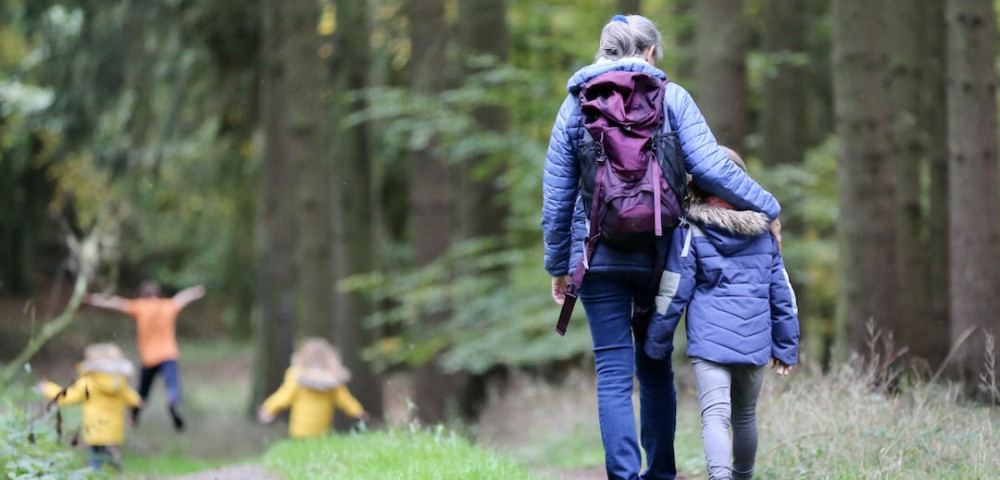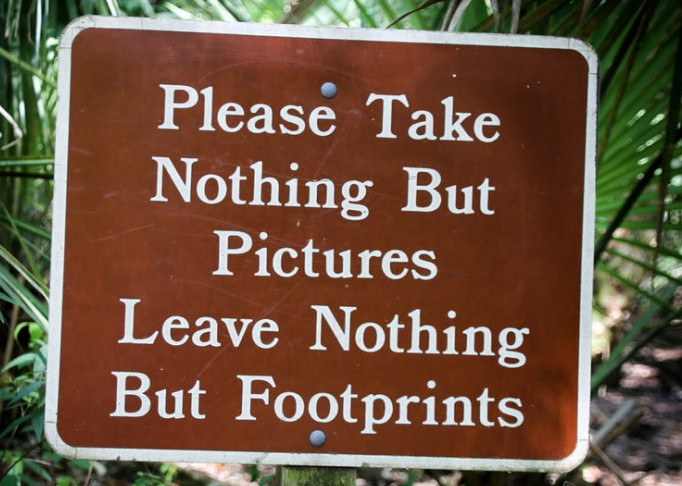
You’ve gone hiking by yourself, with your friends, wife, girlfriend, and boyfriend, and have decided that you love it. It is the perfect way to recharge those internal batteries and clear your mind.
But what about your kids? They could benefit from going on a hike as well. The exercise from running and jumping, no technology, exposure to wildlife, and building their self-confidence.
Hiking can be done all year long. But please be cautious and check the weather before you venture out.
Taking your children hiking has many benefits (more than those listed above) but there are some things that you need to prepare before you go. Every age group is different and may need more attention than others.
Taking Infants on a Hike
You can take your infant children or child hiking with you just like you take them anywhere else. There’s no certain age that says when you can or should start. It’s up to you when your child starts their hiking adventures. If you enjoy hiking, it’s good to get started sooner than later. No babysitter is needed. (Saves you money)
- Make sure the trail you have chosen isn’t too difficult for you. You will be carrying extra weight and it will make a difference.
- Find the right baby carrier. There are hundreds of carriers on the market specifically for hiking. You can visit your local outdoor store or order online. You’ll need to get used to wearing it and your infant will need to be comfortable in it as well.
- Find the right stroller. Yes, you can take strollers hiking. Again, research and find the one that is right for you and your infant.
- Before you go full steam ahead, ease them into hiking. Take a few easy trails and then go to the more challenging trails. Put them in that new baby carrier or stroller you just bought. Try to plan your hike around nap time.
- Have separate bottles for milk and water. This makes things a little easier, so you’re not constantly cleaning bottles.
- Put a hat or cap on your infant’s head. Make sure it is big enough to cover the head, neck, and shoulders.
Remember to always check the weather first before you leave. You might want to double and even triple-check your pack so you don’t forget anything. Good preparation makes a trip even better.
Taking Toddlers Hiking
That infant you have packed on numerous hikes can now walk on their own. (Thank goodness) Now it’s time to let them explore and enjoy the great outdoors on their own two feet. But before you go, read below for tips on hiking with a toddler.
- Plan lots of extra time. Your new hiker will want to walk, see and touch everything. Let them wander. This will make the hike more enjoyable for them and you.
- Pack a change of clothes. They will get dirty and muddy. You don’t want to take the trail home with you.
- Have a suitable carrier. Little legs get tired quickly so having that carrier will be key to finishing the trail.
- Make sure they have a comfortable pair of sneakers. Let’s be honest, that new pair of boots or shoes you bought will be ruined by the end of the day. A well-broken-in pair of sneakers will go a long way.
- Trail selection is important. Try taking an easy trail for their first few times walking on their own.
- Take lots of breaks. Remember they are just starting so their stamina hasn’t been built up yet.
- Have lots and lots of snacks and water. All that exploring will make them hungry and thirsty.
- Don’t go alone. Ask other adults and kids to accompany you and your little one on your hike. This will benefit all the adults and children involved. The little hikers have some company to enjoy their time with and the adults share carrying the load of extra supplies and even children (if they are nice enough). Remember they will get tired and will most likely need to be carried on the longer hikes.
Above all just have fun and relax. You (and the kids) are out there to decompress, breathe fresh air, and enjoy mother nature. Prepare for your trip extensively and always do your research. No one wants their day spent in the hospital, getting treated for injuries or allergies, getting rained on, or cold.
Double and triple-check your packs to ensure you have everything you need for your day or hours of hiking. And don’t forget to check the weather before you go out.
Taking Grade School-Aged Children Hiking
You have several hours of hiking under your belt, but hiking with school-aged children is a whole new ball game. You have to be well prepared and have eyes on their every move. Now that they can move freely, they will want to explore more and move quickly. You are responsible for this tiny human. You have to watch out for potential threats, life-threatening situations and the weather as always.
- Anything can happen so be prepared. Expect the unexpected.
- This will take a lot of time. There will be several stops, pauses, and complaining. It’s ok because fun will be had.
- Keep your small hiker within sight. Let them know that staying in sight will keep them safe. If they are out of sight, call for them. Always know where they are and what they are doing.
- Teach them the Leave no Trace Behind Principles.
- Get your child a safety whistle and teach them how to use it.
- Try switching them from a water bottle to a water reservoir. Water reservoirs fit easily into the backpack your little hiker is carrying.
- Look for kid-friendly trails. Most websites have a rating system that measures the difficulty of each trail you might want to hike.
- Let them help with planning the day. Let them help decide what trail to hike, the time to go, and maybe pick a place to eat after you finish your hike.
- Everyone bring a friend. Having a friend tag-a-long will make the trip so much more fun. It gives your little one someone to play with and helps keep them entertained.
- Give them something to keep them occupied. Activities like finding leaves with different shapes, colors, rocks, bird watching, and Geocaching.
What is Geocaching?
Geocaching is hunting for and finding hidden objects by using GPS coordinates from a website. This is a very popular activity among hikers of all ages. If you want to know more about geocaching, check out geocaching.com for more details Below you will find a few things to get you started.
- Download the app. You can’t get started without the app. Go to the app store and download the app of your choice and follow the intrsuctions to get started. If they have a phone or some kind of device, then use that if you don’t wish for them to use your phone or device.
- Get permission to enter private land. Geocaches can be hidden and found on private land but it is best to have permission to be there.
- Make sure you log the geocache. Log your find on the app or the logbook so your find count can increase.
- You can hide your own geocache. Join in on the fun with millions of people around the world by leaving your own treasure to find.
There are many other games and activities that you can do with your children while taking them on a hike. It may take a while for them to find the fun in hiking but it will come.
The Benefits of Hiking For Kids
Not only do you benefit from hiking but your kids do as well. There are several opportunities for them to learn and grow physically as well as mentally. Here are some things your child will benefit from while hiking.
- Physical exercise. This is the best benefit your child will get from hiking. All that movement will help your child develop stronger muscles, bone structure and build stamina for longer hikes and play.
- Building problem-solving skills. Which way do we go? How will we get to the other side? There will be obstacles that they will have to get over and around. You know from hiking that there are occasional trees and large rocks on the trail that will be blocking the way. Figuring out a way around obstacles is half the fun. Ask them what they would do and if they see a way past the obstacle.
- Listening skills. Listen for signs of water, the rustling of leaves, animals or other people on the trail. Bird watching is a common way to pass time while hiking. Listen for the calls of your favorite birds.
- Logging and recording information. Have your child draw a picture or write a brief description of what they saw while on the trail. It could be leaves, animals, birds, reptiles, trees or a combination of many things.
- Mental health break. Today’s world is fast-paced even for children. They need a break as much as you do so let’s go hiking!
There isn’t a certain age that you have to wait to start planning your hiking trips that include your child or children. It is up to you when you want them to accompany you on your adventure. Just remember:
- Check the weather before you go
- Plan for the hike to take longer than expected
- Get your child or children to help you plan the hike. This will make the trip more enjoyable.
- Carry extra snacks and water. If they are old enough, have them pack their own snacks and water.
- Have a good pair of comfortable shoes and comfortable clothes to wear.
- Ask friends to tag along and enjoy the hike with you. The more the merrier!
Please be careful out there and enjoy your hike!
 The wild, wilderness, forest (or whatever you call it) can be for everyone to enjoy. I enjoy the peace of it all. When hiking or camping in the wilderness, clean up after yourself. Leaving no trace behind means leaving no trash and leaving things the way you found them.
The wild, wilderness, forest (or whatever you call it) can be for everyone to enjoy. I enjoy the peace of it all. When hiking or camping in the wilderness, clean up after yourself. Leaving no trace behind means leaving no trash and leaving things the way you found them.